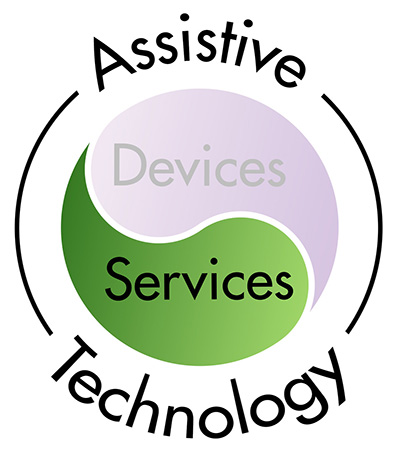What should Ms. Adelaide know about assistive technology and how it is used by students with disabilities?
Page 3: AT Services
 Whether a student is able to succeed using assistive technology depends not only on the student having access to a device but also on having access to AT services. IDEA defines an assistive technology service as “any service that directly assists a child with a disability in the selection, acquisition, or use of an assistive technology device.” (Authority: 20 U.S.C. 1401(1)) or IDEA Amendments of 2004, P.L. 108-446, 20 U.S. C. § 1400 et seq., 300.06)
Whether a student is able to succeed using assistive technology depends not only on the student having access to a device but also on having access to AT services. IDEA defines an assistive technology service as “any service that directly assists a child with a disability in the selection, acquisition, or use of an assistive technology device.” (Authority: 20 U.S.C. 1401(1)) or IDEA Amendments of 2004, P.L. 108-446, 20 U.S. C. § 1400 et seq., 300.06)
Such supports and services entail:
- Evaluating the student’s need for a device
- Buying, leasing, or acquiring the device
- Selecting, fitting, adapting, repairing, or replacing the device as needed
- Coordinating all the needed services for a student who uses a device (e.g., therapies, education)
- Providing training or technical assistance to the student, family, teachers, or others involved in the use of the device
Now listen to our panel of AT experts as they discuss the need for both assistive technology devices and services.

Margaret E. Bausch, EdD
Associate Dean for Research
and Graduate Student Success
Department of Early Childhood, Special
Education and Counselor Education
University of Kentucky, Lexington, KY
(time: 1:15)

Diane Cordry Golden, PhD
Center for Assistive Technology
Act Data Assistance
(time: 1:07)
Transcript: Penny Reed, PhD
Educators need to think about both devices and services, because most AT devices need some kind of training or support. Certainly, there are very simple ones: A slant board could make a significant difference in a student’s ability to write and may serve him or her well in many situations, and that’s not going to need much training. But a lot of assistive technology is computer-based. A lot of it is software these days. A lot of it is free things that are on the Web, but almost all of them need someone to know when they’re working or not working, how to manage to provide training. The law specifies the services that we must provide, and we need to consider those whenever we think about using assistive technology to be sure that it’s appropriately implemented.
Transcript: Margaret Bausch, EdD
It’s mandated by federal law that assistive technology is both devices and services. So we must consider the devices, but then we also must consider the assistive technology services. By services, there are different components in the federal law including assistive technology evaluation, the purchasing of the equipment, or leasing or acquisition of the equipment, the modification of the equipment, any kind of adaptations or set up or modifications that have to be done to the equipment, even a software component. The coordination of those services must be considered. And then the last components deal with training—training of the child and the child’s family, and the training of professionals, those people who work with the student in the school, whether it be a teacher, a paraprofessional, could be someone in the cafeteria if they have to deal with that assistive technology. Anyone who’s using the assistive technology, a related service provider, a speech language pathologist, occupational therapist, physical therapist, all of those fall into that training component.
Transcript: Diane Cordry Golden, PhD
The reason you consider both devices and services is literally because, without the services, most people will understand the need to consider the devices and they sort of forget about the services or it becomes a secondary issue that they do not pay as much attention to. For those of us who work with AT on an ongoing basis, we all know the services can make or break the device, a) being the right device, and b) being used. If you don’t have the right services upfront to make a good decision about the AT device and then if you don’t have the good services on the back end to make sure that the device can be used and is used appropriately, really getting the device to the child becomes meaningless. We’ve all seen the devices that are not the right device, and we’ve all seen the devices that aren’t used or are not used appropriately. The services really become as critical to the end-goal of the AT device, providing access to education or providing the ability to do academics.
Research Shows
A recent review of research on the use of assistive technology found that although AT provides many benefits for students, several factors including inadequate training and lack of support from others, can impede its effective use.
(McNicholl, A., Casey, H., Desmond, D., & Gallagher, P., 2019)
Revisiting the Challenge: Brooke’s AT Services
 In addition to Brooke telling Ms. Adelaide about her AT devices, Mr. Edwards, the special education teacher, tells her about the AT services in Brooke’s IEP. These include training on:
In addition to Brooke telling Ms. Adelaide about her AT devices, Mr. Edwards, the special education teacher, tells her about the AT services in Brooke’s IEP. These include training on:
- Using software and hardware across different environments (e.g., school, home, community)
- Troubleshooting and making minor repairs to AT devices, including who to contact for technical support
Mr. Edwards explains that this training is available for Brooke, her teachers, and her family, should they need or want it. He reminds Ms. Adelaide that the IEP team will meet within the next two weeks to review Brooke’s IEP. As part of that meeting, Mr. Edwards wants to ensure that the entire educational staff is comfortable supporting her assistive technology needs.
